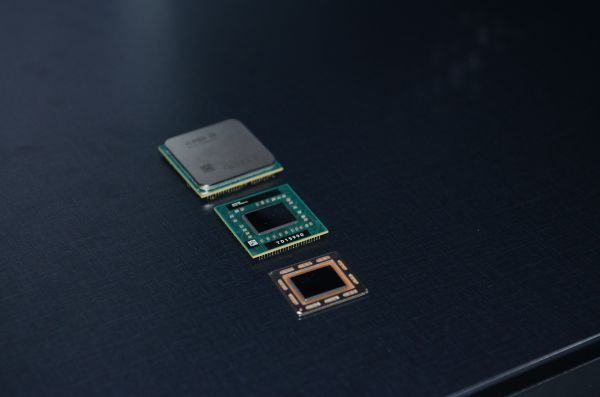AMD's Trinity APU at CES, Shipping in Mid-2012
by Anand Lal Shimpi on January 12, 2012 8:45 PM ESTAMD has a bunch of cool stuff to show off at this year's CES. The first is the most expected: a demo of its upcoming Trinity APU. The demo started out with a desktop chassis driving two displays: one transcoding video using the CPU cores and one playing DiRT 3 at low quality settings. The big surprise is at the end of the video below.
Trinity will be available in the middle of the year in three configurations: a 65W - 100W TDP desktop part, a 35 - 45W notebook part and a 17W ULV part. The three are pictured below in that order:
AMD claims the 17W Trinity should offer similar aggregate CPU/GPU performance to existing Llano notebook APUs at ~35W. The standard voltage notebook Trinity APU will offer a 25% increase in CPU performance and a 50% increase in GPU performance over the A-series Llano APUs available today. Finally the desktop Trinity will be 15% faster on the CPU side and 25% faster on the GPU. Although AMD didn't disclose details, it's likely that these numbers are comparing a two-module Piledriver based Trinity to a quad-core Llano.
The CPU gains seem modest on the desktop Trinity, but the standard voltage notebook part is pretty interesting as the gains should be enough to mostly bring it up to mobile Sandy Bridge performance (if AMD's numbers are correct).
Trinity is likely going to maintain the integrated GPU performance advantage AMD currently holds, even when Ivy Bridge arrives.











44 Comments
View All Comments
R3MF - Friday, January 13, 2012 - link
process change?both llano and trinity are manufactured on 32n?
frozentundra123456 - Friday, January 13, 2012 - link
That is my point though. It is not a die shrink, and the architecture is based on an architecture that has slower IPC than Llano. So I stick by my previous statement that it is a very optimistic claim to say they will get a 50% increase in performance/watt.I am not saying it is impossible, but such a big jump without a die shrink and/or new architecture is very rare.
french toast - Friday, January 13, 2012 - link
Yea i understand what your getting at, however i might add that the pecieved problems with BD seems to be more cache limited...specifically dreadfull latency, also the process has been terrible.Which has led to lower than planned frequency targets, and higher than planned thermals/power consumption.
There is a possibility of them fixing the above and extracting more performance...unlikely though.
More suprising is the 50% claim of graphics improvement, surely thats a mighty jump on the same process isn't it?
Jambe - Friday, January 13, 2012 - link
"Finally the desktop Trinity will be 15% faster on the CPU side and 25% faster on the GPU."I'm really more interested in the GPU getting quicker than the CPU, at least insofar as these all-in-one solutions drive down the cost (and increase the capabilities of) low-end budget gaming PCs.
It's a good thing, although one wonders if a company like AMD would deliberately hold back the GPU capabilities of an integrated solution like this so they can wring more profit out of their discrete GPU business, or if they're willing to just keep progressively-sacrificing the low-tier video cards by offering integrated solutions that are just as (if not more) powerful.
Morg. - Friday, January 13, 2012 - link
Good question . but tbh if AMD can take even 50% of the mobile market thanks to Fusion, they won't need to sell low-tier gfx --I don't believe they would have any interest in holding back any advantage they have now, they're still valued at 1/20th Intel or 1/3rd nVidia - which is retarded but w/e
SleepyFE - Friday, January 13, 2012 - link
A stronger GPU might not sense since it does not have it's own memory (it uses system RAM, making it slower).SilentSin - Friday, January 13, 2012 - link
I'm still confused as to whether or not this was actually a 17W part. Anand can you confirm if you asked this directly or not? I haven't seen that answer on video, just as part of the write ups about the demo which could have easily been misconstrued from AMD saying Trinity *will* go down to 17W, not that the demo *was* a 17W part.Beenthere - Friday, January 13, 2012 - link
It sounds like Trinity laptop chippies may be even better than advertised previously, which is still a good leap forward. No InHell products in this office. Trinity works for me.B3an - Saturday, January 14, 2012 - link
You do realise how many tech sites and reporters there are out there right?? And i mean big ones too, as this site isn't the only large tech site around by a long shot. It's very likely Anand simply couldn't get an earlier time with AMD.FFS why so many stupid comments on this site lately??
B3an - Saturday, January 14, 2012 - link
Grow some brain cells yeah?1. AMD presence at CES was WAY smaller than Intels.
2. Anand didn't have a meeting with AMD until after Intel. Theres only about a million other reporters and sites that AMD have to see. Cant magically see everyone at once.
3. AMD's Bulldozeer is utter crap. So obviously things like that will not get shining reviews.
But of course being as fanboys are mentally immature retards that have never fully grown up, i'm sure all this will appear as "bias" to some people.